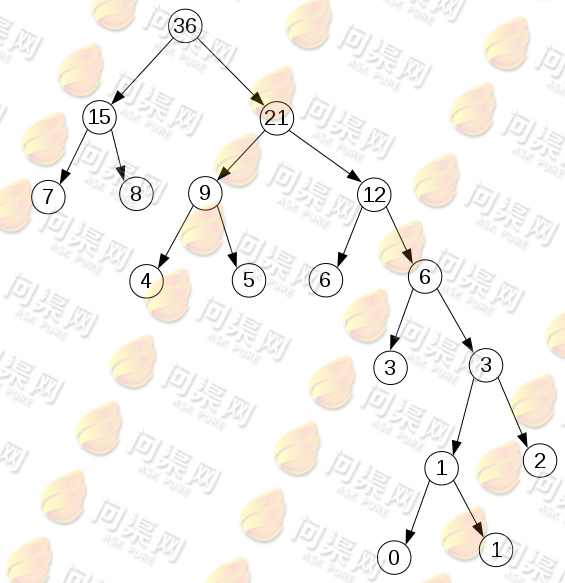数据结构实战
本文作者:李德强
第五节 哈夫曼树
哈夫曼树是最优二叉树,它的特点是所有叶子节点上的权重之和最小的树。构建哈夫曼树的过程如下:
- 将所有叶子节点置于一个集合中。
- 从集合中取出权重最小的两个节点。
- 将这两个节点分别做为一个新节点的左节点和右节点,将两个节点的权重相加作为新节点的权重。
- 将这两个节点从集合中删除。
- 将新节点的加入集合中。
- 重复第2步,直至集合中只有1个节点为止。
构建哈夫曼树的过程很简单,但是需要用到另外一个辅助数据结构:有序链表。我们将实现一个有序链表存放构建哈夫曼树的节点:
#include "typedef.h"
//表数据结构
typedef struct s_list
{
//权重
int weights;
//数据项
void *data;
//头节点
struct s_list *next;
} s_list;
//按升序插入链表
bool list_insert(s_list *list, int weights, void *data)
{
if (list == null || data == null)
{
return false;
}
//申请新节点内存
s_list *p_new = (s_list *) malloc(sizeof(s_list));
p_new->weights = weights;
p_new->data = data;
p_new->next = null;
//第一个节点
if (list->next == null)
{
list->next = p_new;
return true;
}
//按顺序插入节点
s_list *p = list;
while (p->next != null)
{
//只在权重小于下一个节点时插入
if (p_new->weights <= p->next->weights)
{
//插入新节点
p_new->next = p->next;
p->next = p_new;
return true;
}
p = p->next;
}
p->next = p_new;
return true;
}
//删除链表中指定元素节点
bool list_delete(s_list *list, void *data)
{
if (list == null)
{
return false;
}
s_list *p = list;
while (p->next != null)
{
//找到数据相同的节点
if (p->next->data == data)
{
//删除节点
s_list *p_del = p->next;
p->next = p_del->next;
//释放内存
free(p_del);
return true;
}
p = p->next;
}
return false;
}
再来实现一个哈夫曼树:
//赫夫曼节点
typedef struct s_node
{
//数据指针
void *data;
//父节点
struct s_node *parent;
//左孩子节点
struct s_node *left_child;
//右孩子节点
struct s_node *right_child;
} s_node;
//赫夫曼数据结构
typedef struct s_tree
{
//根节点
s_node *root;
//访问函数指针
void (*visit_node)();
//释放内存函数指针
void (*free_node)();
} s_tree;
//由一个有序链表构建赫夫曼树
bool tree_create(s_tree *tree, s_list *list)
{
if (tree == null)
{
return false;
}
if (list == null)
{
return false;
}
if (list->next == null)
{
return false;
}
//当有序链表中前两个节点不为空时
while (list->next != null && list->next->next != null)
{
//取出有序链表中第一个节点
s_list *p0 = list->next;
//取出有序链表中第二个节点
s_list *p1 = list->next->next;
//取得树节点,权重小的为左节点,权重大的为右节点,
s_node *n_left = (s_node *) p0->data;
s_node *n_right = (s_node *) p1->data;
//权重相同时无子树的为左节点
if (p0->weights == p1->weights)
{
s_node *n_temp = n_left;
n_left = n_right;
n_right = n_temp;
}
//申请新节点内存
s_node *n_node = (s_node *) malloc(sizeof(s_node));
//权重相加
int weights = p0->weights + p1->weights;
//删除有序链表中的前两个节点
list_delete(list, p0->data);
list_delete(list, p1->data);
//构建新节点
n_node->data = null;
n_node->left_child = n_left;
n_node->right_child = n_right;
n_left->parent = n_node;
n_right->parent = n_node;
//将新节点插入有序链表
list_insert(list, weights, n_node);
}
//经由上面处理后,有序链表中只留下一个节点
s_list *p = list->next;
//取得二叉树的根节点
s_node *n_root = (s_node *) p->data;
//设定二叉树的根节点
tree->root = n_root;
return true;
}
//前序遍历
void tree_preamble_visit(s_tree *tree, s_node *node)
{
if (tree == null)
{
return;
}
if (tree->root == null)
{
return;
}
if (node == null)
{
return;
}
//中
tree->visit_node(node->data);
//左
tree_preamble_visit(tree, node->left_child);
//右
tree_preamble_visit(tree, node->right_child);
}
最后来实现两个例子,测试我们的哈夫曼树:
#include <stdio.h>
#include <stdlib.h>
#include <string.h>
#include "tree.h"
#include "list.h"
//删除整数函数
void free_int(int *i)
{
if (i != null)
{
free(i);
}
}
//访问整数函数
void visit_int(int *i)
{
if (i != null)
{
printf("%d ", *i);
}
}
void sample_A()
{
s_list *list = (s_list *) malloc(sizeof(s_list));
list->weights = 0;
list->data = null;
list->next = null;
s_tree tree;
tree_init(&tree, &visit_int, &free_int);
int *t0 = (int *) malloc(sizeof(int));
int *t1 = (int *) malloc(sizeof(int));
int *t2 = (int *) malloc(sizeof(int));
int *t3 = (int *) malloc(sizeof(int));
int *t4 = (int *) malloc(sizeof(int));
int *t5 = (int *) malloc(sizeof(int));
int *t6 = (int *) malloc(sizeof(int));
int *t7 = (int *) malloc(sizeof(int));
int *t8 = (int *) malloc(sizeof(int));
*t0 = 0;
*t1 = 1;
*t2 = 2;
*t3 = 3;
*t4 = 4;
*t5 = 5;
*t6 = 6;
*t7 = 7;
*t8 = 8;
s_node *n0 = (s_node *) malloc(sizeof(s_node));
s_node *n1 = (s_node *) malloc(sizeof(s_node));
s_node *n2 = (s_node *) malloc(sizeof(s_node));
s_node *n3 = (s_node *) malloc(sizeof(s_node));
s_node *n4 = (s_node *) malloc(sizeof(s_node));
s_node *n5 = (s_node *) malloc(sizeof(s_node));
s_node *n6 = (s_node *) malloc(sizeof(s_node));
s_node *n7 = (s_node *) malloc(sizeof(s_node));
s_node *n8 = (s_node *) malloc(sizeof(s_node));
tree_init_node(n0, t0);
tree_init_node(n1, t1);
tree_init_node(n2, t2);
tree_init_node(n3, t3);
tree_init_node(n4, t4);
tree_init_node(n5, t5);
tree_init_node(n6, t6);
tree_init_node(n7, t7);
tree_init_node(n8, t8);
list_insert(list, 0, n0);
list_insert(list, 1, n1);
list_insert(list, 2, n2);
list_insert(list, 3, n3);
list_insert(list, 4, n4);
list_insert(list, 5, n5);
list_insert(list, 6, n6);
list_insert(list, 7, n7);
list_insert(list, 8, n8);
tree_create(&tree, list);
//前序遍历
tree_preamble_visit(&tree, tree.root);
printf("\n");
//销毁树
tree_destroy(&tree);
free(list);
}
void sample_B()
{
s_list *list = (s_list *) malloc(sizeof(s_list));
list->weights = 0;
list->data = null;
list->next = null;
s_tree tree;
tree_init(&tree, &visit_int, &free_int);
int *t0 = (int *) malloc(sizeof(char));
int *t1 = (int *) malloc(sizeof(char));
int *t2 = (int *) malloc(sizeof(char));
int *t3 = (int *) malloc(sizeof(char));
int *t4 = (int *) malloc(sizeof(char));
int *t5 = (int *) malloc(sizeof(char));
int *t6 = (int *) malloc(sizeof(char));
int *t7 = (int *) malloc(sizeof(char));
*t0 = 5;
*t1 = 29;
*t2 = 7;
*t3 = 8;
*t4 = 14;
*t5 = 23;
*t6 = 3;
*t7 = 11;
s_node *n0 = (s_node *) malloc(sizeof(s_node));
s_node *n1 = (s_node *) malloc(sizeof(s_node));
s_node *n2 = (s_node *) malloc(sizeof(s_node));
s_node *n3 = (s_node *) malloc(sizeof(s_node));
s_node *n4 = (s_node *) malloc(sizeof(s_node));
s_node *n5 = (s_node *) malloc(sizeof(s_node));
s_node *n6 = (s_node *) malloc(sizeof(s_node));
s_node *n7 = (s_node *) malloc(sizeof(s_node));
tree_init_node(n0, t0);
tree_init_node(n1, t1);
tree_init_node(n2, t2);
tree_init_node(n3, t3);
tree_init_node(n4, t4);
tree_init_node(n5, t5);
tree_init_node(n6, t6);
tree_init_node(n7, t7);
list_insert(list, 5, n0);
list_insert(list, 29, n1);
list_insert(list, 7, n2);
list_insert(list, 8, n3);
list_insert(list, 14, n4);
list_insert(list, 23, n5);
list_insert(list, 3, n6);
list_insert(list, 11, n7);
tree_create(&tree, list);
//前序遍历
tree_preamble_visit(&tree, tree.root);
printf("\n");
//销毁树
tree_destroy(&tree);
free(list);
}
int main(int argc, char **args)
{
sample_A();
sample_B();
return 0;
}
运行结果:
7 8 4 5 6 3 0 1 2 8 11 23 29 14 7 3 5
这两个哈夫曼树如下:


本例代码:
code path chapter.05/e.g.5.5/ https https://github.com/magicworldos/datastructure.git git git@github.com:magicworldos/datastructure.git subverion https://github.com/magicworldos/datastructure
Copyright © 2015-2023 问渠网 辽ICP备15013245号